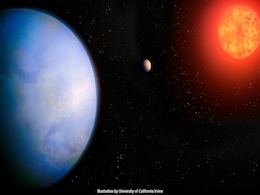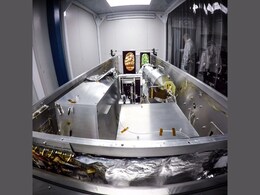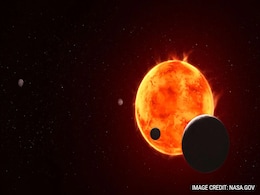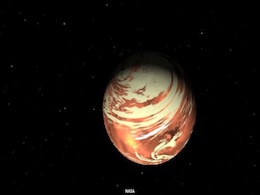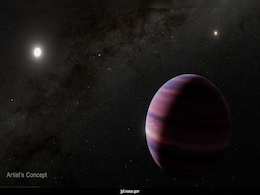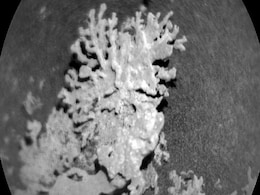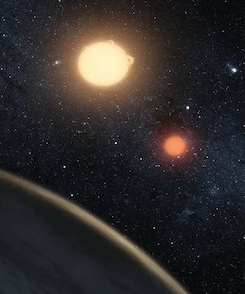Habitable Planets
- All
- News
- Web Stories
-

Early Earth’s Deep Mantle May Have Held More Water Than Previously Believed, Study Finds
- Sunday December 14, 2025
- Written by Gadgets 360 Staff
Scientists have discovered that Earth’s deep mantle may have stored an ocean’s worth of water during the planet’s earliest years. New experiments show that bridgmanite, a dominant mantle mineral, can hold much more water under extreme heat, offering fresh insight into how Earth retained water and became habitable.
-
 www.gadgets360.com
www.gadgets360.com
-

TRAPPIST-1e Methane Signal Likely False, Webb Data Suggests Airless Planet
- Thursday December 11, 2025
- Written by Gadgets 360 Staff
The TRAPPIST-1 planetary system, located about 39 light-years from Earth, hosts seven rocky worlds orbiting a cool red dwarf star. While several of these Earth-sized planets lie in the star’s habitable zone, new observations from the James Webb Space Telescope suggest their atmospheres may be too thin to support life. Earlier hints of methane aro...
-
 www.gadgets360.com
www.gadgets360.com
-

AI-Assisted Study Finds No Evidence of Liquid Water in Mars’ Seasonal Dark Streaks
- Friday November 14, 2025
- Written by Gadgets 360 Staff
A large-scale AI analysis of more than two million Mars orbiter images shows that the planet’s dark slope streaks form through seasonal dust avalanches, not flowing briny water. The results settle a long-running debate, revealing that wind-driven dust activity shapes Mars’ surface and offering new insights into the planet’s climate past and e...
-
 www.gadgets360.com
www.gadgets360.com
-

Astronomers Spot First Coronal Mass Ejection from a Distant Star, Raising Questions About Planetary Habitability
- Monday November 17, 2025
- Written by Gadgets 360 Staff
Astronomers detected the first coronal mass ejection from a distant star, revealing that powerful stellar eruptions may strip atmospheres from nearby planets, affecting exoplanet habitability and the search for life.
-
 www.gadgets360.com
www.gadgets360.com
-

Planets Could Create Their Own Water While Forming, Expanding Possibilities for Habitable Worlds
- Tuesday November 11, 2025
- Written by Gadgets 360 Staff
Lab experiments show planets can generate water during formation, not just via comets. This suggests habitable conditions may be widespread in the galaxy, expanding possibilities for life-friendly exoplanets.
-
 www.gadgets360.com
www.gadgets360.com
-

Possible 'Super-Earth' Discovered Just 20 Light-Years Away, Say Scientists
- Saturday October 25, 2025
- Science | Edited by Nikhil Pandey
The rocky exoplanet is nearly four times Earth's mass and may offer new insights in the search for habitable worlds.
-
 www.ndtv.com
www.ndtv.com
-

Newly Found ‘Super-Earth’ GJ 251 c Could Be One of the Most Promising Worlds for Alien Life
- Sunday October 26, 2025
- Written by Gadgets 360 Staff
A new super-Earth, GJ 251 c, has been found orbiting a nearby red dwarf star within its habitable zone. About four times Earth’s mass, it may host liquid water. Detected via the radial-velocity method using Penn State’s Habitable Zone Planet Finder, it’s a prime target in the search for life.
-
 www.gadgets360.com
www.gadgets360.com
-

Kepler and TESS Discoveries Help Astronomers Confirm Over 6,000 Exoplanets Orbiting Other Stars
- Saturday December 13, 2025
- Written by Gadgets 360 Staff
More than 6,000 exoplanets (planets orbiting other stars), one of the most rapidly expanding frontiers in science, have now been confirmed by astronomers. Their search of other worlds has been transformed within a span of thirty years, which started as a form of speculation, to accurate detection. However, in the midst of this wave of discoveries, ...
-
 www.gadgets360.com
www.gadgets360.com
-

White Dwarf Gobbles Up Nitrogen-Rich Ices of Pluto-Like World
- Friday September 26, 2025
- World News | Reuters
Astronomers have observed a white dwarf, a highly compact stellar ember, that appears to have gobbled up an icy world akin to dwarf planet Pluto, a finding with implications regarding the likelihood of habitable planets beyond our solar system
-
 www.ndtv.com
www.ndtv.com
-

Not Like Venus Or Mars, Distant Exoplanet May Have Atmosphere Like Earth's
- Friday September 19, 2025
- World News | Edited by NDTV News Desk
A distant exoplanet might have an atmosphere similar to Earth's, early observations from the James Webb Space Telescope (JWST) suggest. It is part of a group of planets orbiting a star called TRAPPIST-1, about 40 light-years away from Earth.
-
 www.ndtv.com
www.ndtv.com
-

James Webb Spots Bizarre Planet-Forming Disk Full of Carbon Dioxide
- Friday September 5, 2025
- Written by Gadgets 360 Staff
The James Webb Space Telescope has spotted a bizarre planet-forming disk dominated by carbon dioxide where water is almost absent. This rare finding, in star system XUE 10 within NGC 6357, challenges current models of planetary formation and may reshape our understanding of habitable worlds.
-
 www.gadgets360.com
www.gadgets360.com
-

NASA Telescope Detects Possible Signs Of Alien Life On Distant 'Water World'
- Wednesday August 27, 2025
- Science | Edited by Nikhil Pandey
Researchers using the Webb telescope found traces of two gases, dimethyl sulfide (DMS) and dimethyl disulfide (DMDS), in the atmosphere of K2-18b, a planet 124 light-years away.
-
 www.ndtv.com
www.ndtv.com
-

A New 'Earth' Next Door? Scientists Detect Possible Habitable Planet Around Closest Sun-Like Star
- Friday August 15, 2025
- Science | Edited by Nikhil Pandey
Astronomers using JWST have detected a giant exoplanet in the habitable zone of Alpha Centauri A, our nearest Sun-like star.
-
 www.ndtv.com
www.ndtv.com
-

NASA’s Curiosity Rover Spots Ancient Coral-Like Rock on Mars
- Tuesday August 12, 2025
- Written by Gadgets 360 Staff
On July 24, 2025, NASA’s Curiosity Mars rover captured an image of a small, coral-shaped rock in Gale Crater using its ChemCam Remote Micro Imager. The light-colored, 1-inch (2.5 cm) formation likely formed billions of years ago when mineral-rich water seeped into tiny fractures in the rock, leaving behind hardened mineral veins after evaporation...
-
 www.gadgets360.com
www.gadgets360.com
-

Early Earth’s Deep Mantle May Have Held More Water Than Previously Believed, Study Finds
- Sunday December 14, 2025
- Written by Gadgets 360 Staff
Scientists have discovered that Earth’s deep mantle may have stored an ocean’s worth of water during the planet’s earliest years. New experiments show that bridgmanite, a dominant mantle mineral, can hold much more water under extreme heat, offering fresh insight into how Earth retained water and became habitable.
-
 www.gadgets360.com
www.gadgets360.com
-

TRAPPIST-1e Methane Signal Likely False, Webb Data Suggests Airless Planet
- Thursday December 11, 2025
- Written by Gadgets 360 Staff
The TRAPPIST-1 planetary system, located about 39 light-years from Earth, hosts seven rocky worlds orbiting a cool red dwarf star. While several of these Earth-sized planets lie in the star’s habitable zone, new observations from the James Webb Space Telescope suggest their atmospheres may be too thin to support life. Earlier hints of methane aro...
-
 www.gadgets360.com
www.gadgets360.com
-

AI-Assisted Study Finds No Evidence of Liquid Water in Mars’ Seasonal Dark Streaks
- Friday November 14, 2025
- Written by Gadgets 360 Staff
A large-scale AI analysis of more than two million Mars orbiter images shows that the planet’s dark slope streaks form through seasonal dust avalanches, not flowing briny water. The results settle a long-running debate, revealing that wind-driven dust activity shapes Mars’ surface and offering new insights into the planet’s climate past and e...
-
 www.gadgets360.com
www.gadgets360.com
-

Astronomers Spot First Coronal Mass Ejection from a Distant Star, Raising Questions About Planetary Habitability
- Monday November 17, 2025
- Written by Gadgets 360 Staff
Astronomers detected the first coronal mass ejection from a distant star, revealing that powerful stellar eruptions may strip atmospheres from nearby planets, affecting exoplanet habitability and the search for life.
-
 www.gadgets360.com
www.gadgets360.com
-

Planets Could Create Their Own Water While Forming, Expanding Possibilities for Habitable Worlds
- Tuesday November 11, 2025
- Written by Gadgets 360 Staff
Lab experiments show planets can generate water during formation, not just via comets. This suggests habitable conditions may be widespread in the galaxy, expanding possibilities for life-friendly exoplanets.
-
 www.gadgets360.com
www.gadgets360.com
-

Possible 'Super-Earth' Discovered Just 20 Light-Years Away, Say Scientists
- Saturday October 25, 2025
- Science | Edited by Nikhil Pandey
The rocky exoplanet is nearly four times Earth's mass and may offer new insights in the search for habitable worlds.
-
 www.ndtv.com
www.ndtv.com
-

Newly Found ‘Super-Earth’ GJ 251 c Could Be One of the Most Promising Worlds for Alien Life
- Sunday October 26, 2025
- Written by Gadgets 360 Staff
A new super-Earth, GJ 251 c, has been found orbiting a nearby red dwarf star within its habitable zone. About four times Earth’s mass, it may host liquid water. Detected via the radial-velocity method using Penn State’s Habitable Zone Planet Finder, it’s a prime target in the search for life.
-
 www.gadgets360.com
www.gadgets360.com
-

Kepler and TESS Discoveries Help Astronomers Confirm Over 6,000 Exoplanets Orbiting Other Stars
- Saturday December 13, 2025
- Written by Gadgets 360 Staff
More than 6,000 exoplanets (planets orbiting other stars), one of the most rapidly expanding frontiers in science, have now been confirmed by astronomers. Their search of other worlds has been transformed within a span of thirty years, which started as a form of speculation, to accurate detection. However, in the midst of this wave of discoveries, ...
-
 www.gadgets360.com
www.gadgets360.com
-

White Dwarf Gobbles Up Nitrogen-Rich Ices of Pluto-Like World
- Friday September 26, 2025
- World News | Reuters
Astronomers have observed a white dwarf, a highly compact stellar ember, that appears to have gobbled up an icy world akin to dwarf planet Pluto, a finding with implications regarding the likelihood of habitable planets beyond our solar system
-
 www.ndtv.com
www.ndtv.com
-

Not Like Venus Or Mars, Distant Exoplanet May Have Atmosphere Like Earth's
- Friday September 19, 2025
- World News | Edited by NDTV News Desk
A distant exoplanet might have an atmosphere similar to Earth's, early observations from the James Webb Space Telescope (JWST) suggest. It is part of a group of planets orbiting a star called TRAPPIST-1, about 40 light-years away from Earth.
-
 www.ndtv.com
www.ndtv.com
-

James Webb Spots Bizarre Planet-Forming Disk Full of Carbon Dioxide
- Friday September 5, 2025
- Written by Gadgets 360 Staff
The James Webb Space Telescope has spotted a bizarre planet-forming disk dominated by carbon dioxide where water is almost absent. This rare finding, in star system XUE 10 within NGC 6357, challenges current models of planetary formation and may reshape our understanding of habitable worlds.
-
 www.gadgets360.com
www.gadgets360.com
-

NASA Telescope Detects Possible Signs Of Alien Life On Distant 'Water World'
- Wednesday August 27, 2025
- Science | Edited by Nikhil Pandey
Researchers using the Webb telescope found traces of two gases, dimethyl sulfide (DMS) and dimethyl disulfide (DMDS), in the atmosphere of K2-18b, a planet 124 light-years away.
-
 www.ndtv.com
www.ndtv.com
-

A New 'Earth' Next Door? Scientists Detect Possible Habitable Planet Around Closest Sun-Like Star
- Friday August 15, 2025
- Science | Edited by Nikhil Pandey
Astronomers using JWST have detected a giant exoplanet in the habitable zone of Alpha Centauri A, our nearest Sun-like star.
-
 www.ndtv.com
www.ndtv.com
-

NASA’s Curiosity Rover Spots Ancient Coral-Like Rock on Mars
- Tuesday August 12, 2025
- Written by Gadgets 360 Staff
On July 24, 2025, NASA’s Curiosity Mars rover captured an image of a small, coral-shaped rock in Gale Crater using its ChemCam Remote Micro Imager. The light-colored, 1-inch (2.5 cm) formation likely formed billions of years ago when mineral-rich water seeped into tiny fractures in the rock, leaving behind hardened mineral veins after evaporation...
-
 www.gadgets360.com
www.gadgets360.com







